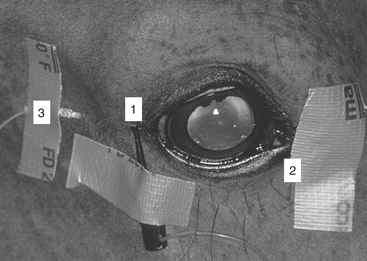CHAPTER 146 Electrodiagnostic Testing for Retinal Disease
Evaluation of the ocular fundus is an important part of ophthalmic examination in horses. However, retinal disease might not always manifest with visible fundic lesions, and it may be difficult to determine objectively the impact of a retinal lesion on visual performance. Several functional tests are available to evaluate or estimate a horse’s visual performance, including assessment of the menace response and use of obstacle courses. Other methods help to evaluate portions of the visual pathways, but they do not assess vision per se (i.e., conscious visual perception) because a positive response does not depend on relaying of the light stimulus through the visual cortex; these tests include assessment of the pupillary light reflex (PLR) and dazzle reflex. Although retinal function is required for a positive test outcome, none of these evaluation methods can specifically measure retinal function because several parts of the visual system are involved. The electroretinogram (ERG) is the only method that specifically and objectively measures retinal function; it is the recorded total electrical response of the retina to a light stimulus. The purpose of this chapter is to introduce practitioners to the use of ERG in horses and discuss the indications for ERG recording.
TECHNICAL ASPECTS OF ELECTRORETINOGRAPHY
Recording System
Similar to other electrophysiologic recording techniques, three electrodes must be placed to obtain an ERG: a positive or active electrode, a negative or reference electrode, and a ground electrode. The active electrode is placed on the corneal surface. Two types of corneal electrodes have been successfully used in horses: contact lens and fiber electrodes. The primary challenge in standing horses, given the vertically oriented corneal surface, is to ensure that the electrode is not constantly becoming displaced or falling off. This challenge can be addressed by use of contact lenses that are designed for the equine cornea or fiber electrodes that float in the tear film (Figure 146-1).




